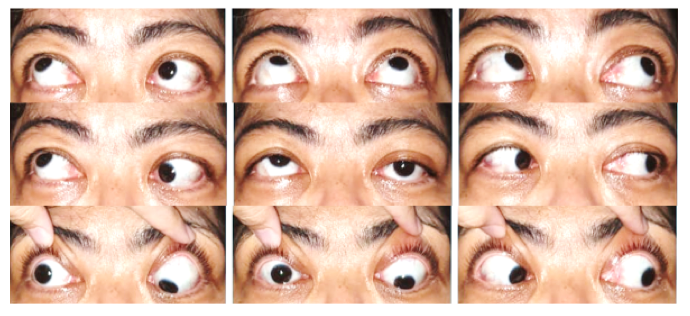SUCCESSFUL MANAGEMENT OF HYPERTROPIA RELATED THYROID EYE DISEASE WITH HEMI HANG-BACK PROCEDURE
Abstract
Introduction: Hypertropia in thyroid eye disease (TED) is uncommon condition which may cause visual and aesthetical problem with quality of life disturbance.
Case Illustration: A 44-year-old woman presented with a squint on the right eye with bilateral diplopia for 18 months. She had history of hyperthyroidism for two years which had been treated with thiamazole and propanolol for 1 year and methylprednisolone for 6 months. Visual acuity of both eyes was 20/20 with no sign of active inflammation and optic neuropathy. Ocular motility showed restriction in lateral and down gaze. Inferior restriction was found in forced duction test. Hypertropia of 40 prism diopters was remarkably seen in Krimsky test. We performed strabismus surgery after patient was in inactive stage and reach euthyroid state without treatment for 6 months. During surgery we found muscle enlargement and fibrous tissue of superior rectus muscle. Superior rectus recession for six milimeters with additional hemi-hang back procedure for two milimeters had been performed with significant improvement of diplopia. Ocular motility exercise was suggested to reach binocular vision.
Discussion: Hypertropia in TED was caused by extraocular muscle fibrosis due to inflammation and lymphocytic infiltration. Strabismus surgery was aimed at diplopia correction in primary position. Surgical procedure, extra ocular muscles in which surgery must be done and its surgical dosage should be considered carefully.
Conclusion: This case showed restrictive hypertropia in TED with distressing symptoms and challenging management. Hemi hang-back procedure is should be considered in difficult case.
Full text article
References
Korn, L. B, Burkat, C.N., Carter, K. D., Perry, J. D., Setabutr, P., Steele, E. A., Vagefi, M.R. 2020. Thyroid Eye Disease in Oculofacial Plastic and Orbital Surgery. Basic and Clinical Science Course 2020-2021. American Academy of Ophthalmology. 2020;4: 75-85.
Shan S.J., Douglas R.S. The pathophysiology of thyroid eye disease. Journal of Neuro-Ophthalmology. 2014;34(2):177-85.
Douglas R.S., McCoy A.N., Gupta S. (editors). Strabismus in Thyroid Eye Disease in Thyroid Eye Disease. Springer; 2014 Nov 27; 99-
Wallang B.S., Kekunnaya R., Granet D. Strabismus surgery in thyroid-related eye disease: strategic decision making. Current Ophthalmology Reports. 2013 Dec;1(4):218-28.
Wang Y., Patel A., Douglas R.S. Thyroid eye disease: how a novel therapy may change the treatment paradigm. Therapeutics and clinical risk management. 2019;15:1305.
Bartalena L, Baldeschi L, Boboridis K, Eckstein A, Kahaly GJ, Marcocci C, Perros P, Salvi M, Wiersinga WM. The 2016 European thyroid Association/European group on Graves' orbitopathy guidelines for the management of Graves' orbitopathy. European thyroid journal. 2016;5(1):9-26.
Hered, R. W, Archer, S.M., Braverman, R. S., Khan, A. O., Lee, K., A., Lueder, G., T., O’Hara, M., A., Tarczy-Hornoch, K. 2020. Surgery of Extraocular Muscle in Pediatric Ophthalmology and Strabismus. Basic and Clinical Science Course 2020-2021. American Academy of Ophthalmology. 2020;14: 164-165.
Lioumi D, Gregson R. Late overcorrections in inferior rectus muscle surgery for vertical squint correction. Ann Ophthalmol. 2000;32:116–9.
Wright K.W., Strube, Y.N.J. Color atlas of strabismus surgery 4th edition. Springer Science Business Media, LLC; 2015.
Kerr NC. The role of thyroid eye disease and other factors in the overcorrection of hypotropia following unilateral adjustable suture recession of the inferior rectus (an american ophthalmological society thesis). Trans Am Ophthalmol Soc. 2011;109: 168–200
Peragallo JH, Velez FG, Demer JL, Pineles SL. Postoperative drift in patients with thyroid ophthalmopathy undergoing unilateral inferior rectus muscle recession. Strabismus. 2013 Mar 1;21(1):23-8.
Schittkowski, M., Fichter N., Guthoff, R. Strabismus surgery in Grave’s disease dose effect relationship and functional results. Klinische Monatsblatter fur Augenheilkunde. 2004 Nov 1; 221(11):941-7
Mills MD, Coats DK, Donahue SP, Wheeler DT. Strabismus surgery for adults: a report by the American Academy of Ophthalmology. Ophthalmology. 2004 Jun 1;111(6):1255-62.
Odehnal M, Malec J, Hlozánek M. Hemi-hangback recession (retroposition) of extraocular muscles. Ceska a slovenska oftalmologie: casopis Ceske oftalmologicke spolecnosti a Slovenske oftalmologicke spolecnosti. 2004 Sep 1;60(5):356-61.
Agrawal S, Singh V, Yadav A, Bangwal S, Katiyar V. Modified adjustable suture hang-back recession: Description of technique and comparison with conventional adjustable hang-back recession. Indian journal of ophthalmology. 2017 Nov;65(11):1183.
Potter WS, Nelson LB, Handa JT. Hemihang-back recession: description of the technique and review of the literature. Ophthalmic Surgery, Lasers and Imaging Retina. 1990 Oct 1;21(10):711-5.
Xu L., Glass, L.R., Kazim M. Reactivation of thyroid eye disease following extraocular muscle surgery. Ophthalmic Plastic & Reconstructive Surgery. 2014 Jan 1;30(1):e5-6.
Authors
Copyright (c) 2023 Maria Debora Niken Larasati, Luki Indriaswati, Delfitri Lutfi

This work is licensed under a Creative Commons Attribution-NonCommercial-ShareAlike 4.0 International License.

